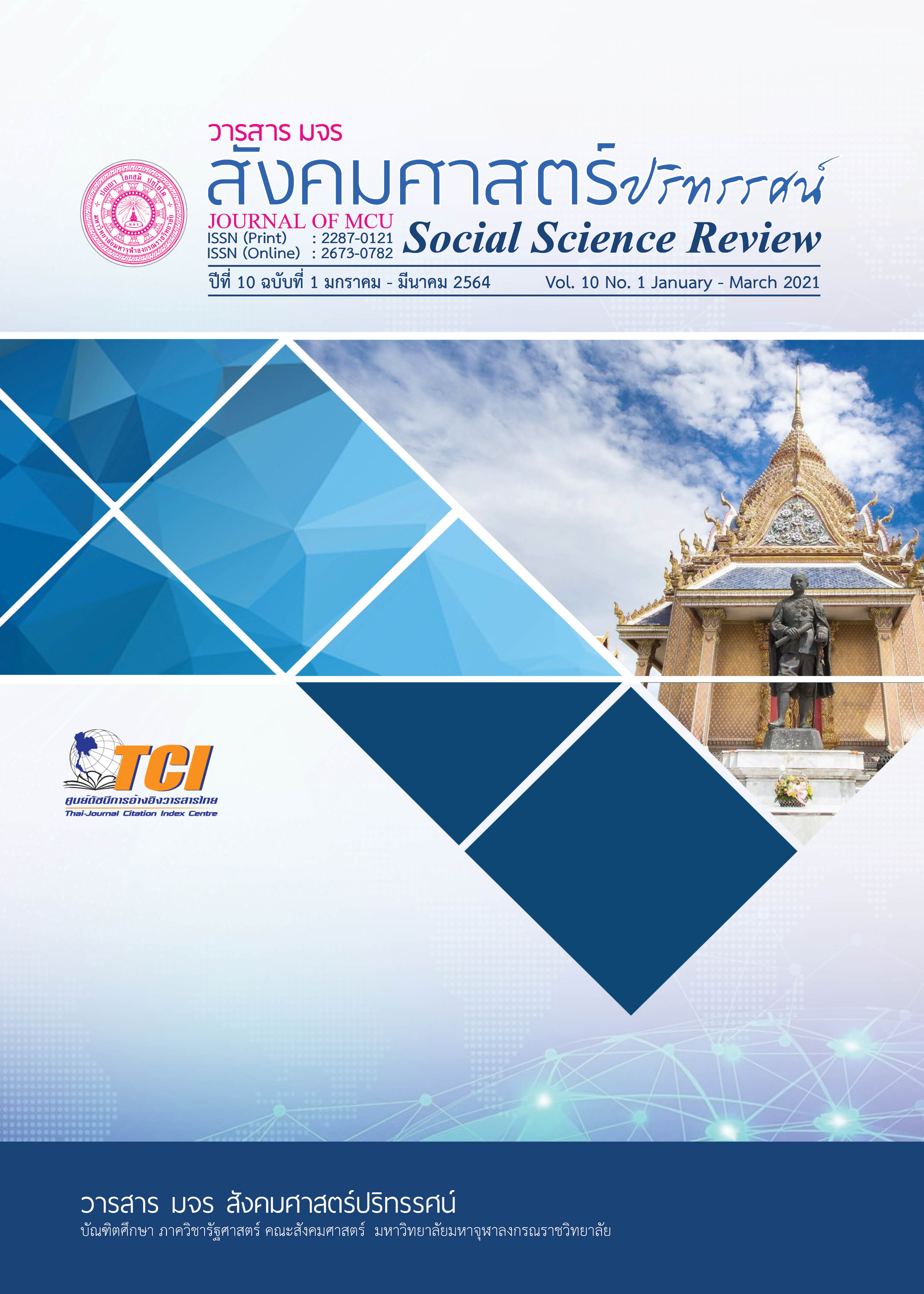รูปแบบการจัดการงานสาธารณสงเคราะห์ในจังหวัดนครปฐม
คำสำคัญ:
รูปแบบ, การพัฒนาศักยภาพ, การจัดการงานสาธารณสงเคราะห์บทคัดย่อ
บทความวิจัยนี้มีวัตถุประสงค์เพื่อศึกษาวิเคราะห์สภาพทั่วไป ระดับการพัฒนาและนำเสนอรูปแบบ เป็นการวิจัยแบบผสานวิธี ประกอบด้วยการวิจัยเชิงคุณภาพเก็บข้อมูลด้วยการสัมภาษณ์เชิงลึก กับผู้ให้ข้อมูลสำคัญ 18 รูปหรือคน และการสนทนากลุ่มเฉพาะกับผู้ทรงคุณวุฒิ 10 รูปหรือคน วิเคราะห์ข้อมูลเชิงพรรณนา เรียบเรียงและจำแนกอย่างเป็นระบบ และการวิจัยเชิงปริมาณ เป็นการวิจัยเชิงสำรวจ จากแบบสอบถาม ซึ่งมีค่าความเชื่อมั่นทั้งฉบับเท่ากับ 0.964 กับพระสงฆ์จังหวัดนครปฐม จำนวน 352 รูป จาก 4,110 รูป สถิติที่ใช้ในการวิจัย คือ ค่าความถี่ ค่าร้อยละ ค่าเฉลี่ย ค่าเบี่ยงเบนมาตรฐาน ผลการวิจัยพบว่า 1. วัดเป็นศูนย์กลางความเจริญ ความเข้มแข็งของชุมชน มีการบริหารจัดการดูแลบริเวณวัดให้เป็นสถานที่ร่มรื่น ร่มเย็น สำหรับประชาชน ใช้เป็นที่พักพิง มีมูลนิธิกองทุน เพื่อช่วยเหลือคนยากจนและผู้ประสบภัยพิบัติ 2. การพัฒนาศักยภาพพระสงฆ์กับการจัดการงานสาธารณสงเคราะห์ในจังหวัดนครปฐมมีความสัมพันธ์กัน จึงยอมรับสมมติฐานการวิจัยที่ตั้งไว้ 3. รูปแบบการจัดการงานสาธารณสงเคราะห์ในจังหวัดนครปฐม มี 4 รูปแบบคือ รูปแบบการบำรุงกิจการเพื่อช่วยเหลือเกื้อกูล รูปแบบการช่วยเหลือเกื้อกูลกิจการของผู้อื่นเพื่อสาธารณประโยชน์ รูปแบบการเกื้อกูลสาธารณสมบัติสถานที่อันเป็นสาธารณสมบัติ รูปแบบการเกื้อกูลประชาชนหรือสรรพสัตว์โดยสงเคราะห์ผู้เดือนร้อน
เอกสารอ้างอิง
ดำรงศักดิ์ จันโททัย. (2549). การจัดการงานสังคมสงเคราะห์โดยมุ่งเน้นความสัมพันธ์กับผู้ใช้บริการ (วิทยานิพนธ์ปริญญาสังคมสงเคราะห์ศาสตรดุษฎีบัณฑิต สาขาวิชาบริการสังคม). กรุงเทพฯ : มหาวิทยาลัยธรรมศาสตร์.
พระครูกิตติวรานุวัตรและคณะ. (2561). บทบาทพระสงฆ์ในการสืบสานวัฒนธรรมไทย. วารสารมหาจุฬานาครทรรศน์, 5(3), 468-487.
พระครูนนทกิจโกศลและคณะ. (2562). การพัฒนารูปแบบการบริหารการเปลี่ยนแปลงสู่ความเป็นเลิศ ของสถาบันพระพุทธศาสนา. วารสารมหาจุฬานาครทรรศน์, 6(1), 55-69.
พระเทพปริยัติสุธี (วรวิทย์ คงฺคปญฺโญ). (2539). การคณะสงฆ์และพระศาสนา. กรุงเทพฯ : โรงพิมพ์มหาจุฬาลงกรณราชวิทยาลัย.
พระพิพัฒน์ ทับงามและคณะ. (2563). รูปแบบการบริหารจัดการของสำนักปฏิบัติธรรมประจำจังหวัดอ่างทองเพื่อเสริมสร้างศักยภาพทางปัญญา. วารสาร สันติศึกษาปริทรรศน์ มจร, 8(1), 222-232.
พระมหาเรืองเดช ถาวรธมฺโม. (2554). การบริหารจัดการกิจการคณะสงฆ์ให้เป็นศูนย์การเรียนรู้ของชุมชนวัดไผ่ล้อม ตำบลจันทนิมิต อำเภอเมืองจันทบุรี จังหวัดจันทบุรี (รายงานการวิจัย). พระนครศรีอยุธยา: มหาวิทยาลัยมหาจุฬาลงกรณราชวิทยาลัย.
สุภัทรชัย สีสะใบและคณะ. (2562). ถอดบทเรียนจากพื้นที่: การดูแลผู้สูงอายุตามแนวพุทธในจังหวัดสมุทรปราการ. วารสารวิจยวิชาการ, 2(1), 149-170.
เสาวนีย์ ไชยกุล และจงจิตร แสงทอง. (2554). บทบาทพระสังฆาธิการที่มีต่อการพัฒนาศาสนศึกษาและการศึกษาสงเคราะห์จังหวัดพะเยา (รายงานการวิจัย). พระนครศรีอยุธยา: มหาวิทยาลัยมหาจุฬาลงกรณราชวิทยาลัย.
ดาวน์โหลด
เผยแพร่แล้ว
รูปแบบการอ้างอิง
ฉบับ
ประเภทบทความ
สัญญาอนุญาต
ลิขสิทธิ์ (c) 2021 วารสาร มจร สังคมศาสตร์ปริทรรศน์

อนุญาตภายใต้เงื่อนไข Creative Commons Attribution-NonCommercial-NoDerivatives 4.0 International License.
เพื่อให้เป็นไปตามกฎหมายลิขสิทธิ์ ผู้นิพนธ์ทุกท่านต้องลงลายมือชื่อในแบบฟอร์มใบมอบลิขสิทธิ์บทความให้แก่วารสารฯ พร้อมกับบทความต้นฉบับที่ได้แก้ไขครั้งสุดท้าย นอกจากนี้ ผู้นิพนธ์ทุกท่านต้องยืนยันว่าบทความต้นฉบับที่ส่งมาตีพิมพ์นั้น ได้ส่งมาตีพิมพ์เฉพาะในวารสาร มจร สังคมศาสตร์ปริทรรศน์ เพียงแห่งเดียวเท่านั้น หากมีการใช้ภาพหรือตารางหรือเนื้อหาอื่นๆ ของผู้นิพนธ์อื่นที่ปรากฏในสิ่งตีพิมพ์อื่นมาแล้ว ผู้นิพนธ์ต้องขออนุญาตเจ้าของลิขสิทธิ์ก่อน พร้อมทั้งแสดงหนังสือที่ได้รับการยินยอมต่อบรรณาธิการ ก่อนที่บทความจะได้รับการตีพิมพ์ หากไม่เป็นไปตามข้อกำหนดเบื้องต้น ทางวารสารจะถอดบทความของท่านออกโดยไม่มีข้อยกเว้นใดๆ ทั้งสิ้น





